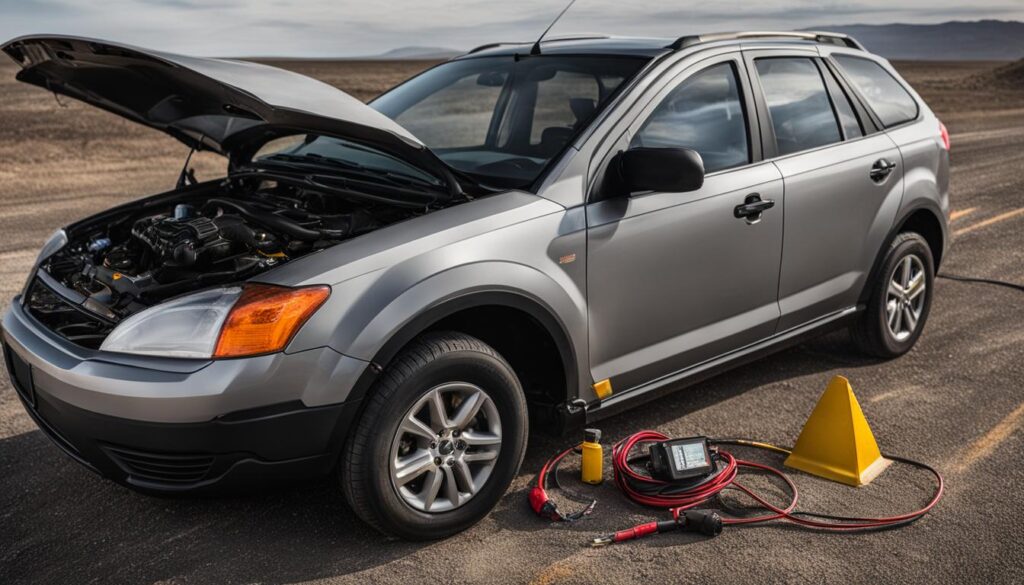A bad or clogged catalytic converter can sometimes cause an engine misfire. However, this is not the most common cause of misfires, as they are typically attributed to spark plugs and other ignition parts. Catalytic converters are designed to convert harmful compounds in emissions into safer compounds. They include reduction catalysts and oxidation catalysts to break up unsafe molecules and remove oxygen or add oxygen to create safer emissions. There are two types of catalytic converters: two-way and three-way, with the three-way being more prevalent in modern engines.
When a catalytic converter becomes clogged, it can cause limited power and restrict the flow of smoke, leading to a misfire. Clogged converters often result from the entry of oil or antifreeze into the exhaust system, causing carbon and soot deposits that block the passage and increase backpressure. It is important to note that a clogged catalytic converter is not the most common cause of misfires, and other components such as spark plugs and ignition-related problems should be checked first.
Key Takeaways:
- A bad catalytic converter can sometimes cause an engine misfire, but it is not the most common cause.
- Misfires are typically attributed to spark plugs and other ignition-related problems.
- Catalytic converters are designed to convert harmful compounds in emissions into safer compounds.
- A clogged catalytic converter can cause limited power and restrict the flow of smoke.
- Other components should be checked first before focusing on the catalytic converter as the cause of a misfire.
Symptoms of a Bad Catalytic Converter Misfire
If you suspect a misfire caused by a bad catalytic converter, it’s important to look out for certain symptoms. These signs can help you identify the potential issue and take appropriate action. Some common symptoms of a bad catalytic converter misfire include:
- Reduced power when accelerating: A clogged catalytic converter can restrict the flow of exhaust gases, making it difficult for the engine to generate power.
- Increased emissions: When the catalytic converter is unable to properly break down pollutants, it can result in the release of harmful gases, leading to increased emissions.
- Poor engine performance: Misfires caused by a bad catalytic converter can manifest as shaking, pressure outbursts, or occasional stalling.
- Rotten smell resembling rotten eggs: A poorly converted catalytic converter can emit a foul odor, often described as similar to rotten eggs.
- Check engine light: An illuminated check engine light may indicate a problem with the catalytic converter, although further inspection is required for confirmation.
“Reduced power when accelerating, increased emissions, poor engine performance, a rotten smell, and an illuminated check engine light can all be indicators of a potential misfire caused by a bad catalytic converter.”
If you observe any of these symptoms, it is essential to address the issue promptly. However, it’s important to note that these symptoms can also be caused by other factors, so a thorough diagnosis is recommended.
| Symptom | Description |
|---|---|
| Reduced power when accelerating | The engine struggles to generate power due to restricted flow caused by a clogged catalytic converter. |
| Increased emissions | The catalytic converter fails to break down pollutants effectively, resulting in higher levels of harmful gases being released. |
| Poor engine performance | Manifests as shaking, pressure outbursts, or occasional stalling due to misfires caused by the catalytic converter. |
| Rotten smell resembling rotten eggs | A foul odor emitted by the catalytic converter, often compared to the smell of rotten eggs. |
| Check engine light | An illuminated check engine light that may indicate a problem with the catalytic converter, requiring further inspection for confirmation. |
Remember, while these symptoms can suggest a misfire caused by a bad catalytic converter, it’s crucial to consult a professional for accurate diagnosis and appropriate measures.
Diagnosing a Misfire Due to a Bad Catalytic Converter
Diagnosing a misfire caused by a bad catalytic converter can be a challenging task. As mentioned earlier, a clogged or faulty catalytic converter is not the most common cause of misfires, so it is important to eliminate other potential culprits first. Begin by checking the condition of the spark plugs, as they are the primary cause of misfires. Inspect them for signs of wear, carbon tracking, or any other abnormalities. Carbon tracking occurs when foreign substances like oil, dirt, or moisture create a conductive path and interfere with the spark plug’s performance. If the spark plugs appear to be in good condition, move on to other ignition-related components such as coil packs, crankshaft position sensors, and wiring.
In addition to inspecting ignition components, it is advisable to perform a vacuum gauge test. This involves attaching a vacuum gauge to the intake manifold to check for any irregularities in vacuum pressure that may be affecting the catalytic converter. A low vacuum pressure reading could suggest an issue with the converter. Furthermore, checking the exhaust backpressure is crucial in diagnosing a misfire caused by a bad catalytic converter. High backpressure is a common indicator of a clogged converter, as it restricts the flow of exhaust gases. If the backpressure reading is significantly higher than normal, it may confirm a malfunctioning catalytic converter as the source of the misfire.
To gain further insight into the performance of the catalytic converter, the temperature of the converter can be measured using an infrared thermometer. By comparing the temperature at the inlet and outlet of the converter, any significant temperature difference may indicate a problem. However, it is important to note that these diagnostic tests should only be performed after ruling out more common causes of misfires and should be conducted by a professional technician with the appropriate equipment and expertise.

Summary:
- Diagnosing a misfire due to a bad catalytic converter can be challenging, as it is not the most common cause of misfires.
- Before suspecting the catalytic converter, check other components commonly associated with misfires such as spark plugs and ignition-related parts.
- Perform diagnostic tests like the vacuum gauge test and exhaust backpressure check to assess the condition of the catalytic converter.
- Measure the temperature of the catalytic converter to identify any significant temperature differences between the inlet and outlet.
- Professional inspection and evaluation are recommended for an accurate diagnosis and resolution of a misfire caused by a bad catalytic converter.
Now that we have discussed the diagnosis of a misfire due to a bad catalytic converter, let’s move on to examining the signs that indicate a failing converter in the next section.
Signs of a Bad Catalytic Converter
When it comes to diagnosing a misfire caused by a bad catalytic converter, it’s important to be aware of the signs that can indicate a problem. The symptoms mentioned earlier, such as reduced power when accelerating, increased emissions, poor engine performance, a rotten egg smell, and an illuminated check engine light, are all indicators of a potential issue with the catalytic converter. These signs are caused by the restricted flow of exhaust gases due to a clogged converter, as well as the converter’s inability to properly break down pollutants.
“Reduced power when accelerating is caused by the restricted flow of exhaust gases due to a clogged catalytic converter.”
In addition to these signs, there are other indications that your catalytic converter may be faulty. These include a noticeable decrease in fuel efficiency, a louder than usual exhaust noise, and visible damage to the converter itself. A decrease in fuel efficiency can occur because a clogged converter restricts the flow of exhaust gases, affecting the overall performance of the engine. A louder exhaust noise can be a result of a damaged or broken catalytic converter, leading to a more pronounced sound. Lastly, visible damage to the converter, such as dents, cracks, or leaks, is a clear sign that it needs to be replaced.
Signs of a Bad Catalytic Converter
1. Reduced power when accelerating
2. Increased emissions
3. Poor engine performance
4. Rotten egg smell
5. Illuminated check engine light
6. Decrease in fuel efficiency
7. Louder than usual exhaust noise
8. Visible damage to the converter

It’s important to pay attention to these signs as they can help identify a bad catalytic converter that may be causing a misfire. However, it’s essential to rule out other common causes of misfires, such as spark plugs and ignition-related problems, before focusing solely on the catalytic converter. If you suspect a problem with your converter, it is recommended to seek professional inspection and diagnostic tests to confirm the issue and determine the appropriate course of action.
Diagnostic Tests for a Bad Catalytic Converter Misfire
When diagnosing a misfire due to a bad catalytic converter, it is essential to perform specific diagnostic tests to confirm the issue. These tests can help identify the presence of a clogged converter and determine the extent of the problem. By conducting these tests, you can troubleshoot and diagnose the misfire more accurately, allowing for appropriate repairs or replacements if necessary.
Exhaust Backpressure Test
The exhaust backpressure test is a crucial diagnostic test for a misfire caused by a bad catalytic converter. It involves checking the pressure in the exhaust system, particularly before and after the catalytic converter. By comparing the pressure readings, you can determine if the converter is clogged and causing the misfire. High backpressure can indicate a restricted flow of exhaust gases, affecting engine performance and leading to misfires.
Infrared Thermometer Test
Using an infrared thermometer, you can measure the temperature of the catalytic converter to assess its functionality. The test involves taking temperature readings at the inlet and outlet of the converter. A significant temperature difference between the two points can indicate a problem with the converter. If the converter is not functioning properly, it may not be effectively breaking down pollutants, leading to misfires and other related symptoms.
Vacuum Gauge Test
The vacuum gauge test is another diagnostic test that can help diagnose a misfire due to a bad catalytic converter. This test involves attaching a vacuum gauge to the intake manifold and monitoring the vacuum pressure. Abnormalities in the vacuum pressure can indicate issues that may be affecting the performance of the catalytic converter. By conducting this test, you can identify any potential vacuum leaks or other problems that could be contributing to the misfire.
| Diagnostic Test | Description |
|---|---|
| Exhaust Backpressure Test | Measures the pressure in the exhaust system to identify clogged catalytic converters. |
| Infrared Thermometer Test | Measures the temperature difference between the inlet and outlet of the catalytic converter to assess functionality. |
| Vacuum Gauge Test | Checks vacuum pressure to identify any abnormalities that may affect catalytic converter performance. |

By performing these diagnostic tests, you can effectively diagnose a misfire caused by a bad catalytic converter. However, it is important to note that these tests should be performed after ruling out other common causes of misfires, such as spark plugs and ignition-related problems. Consulting with a professional mechanic or technician is recommended for accurate diagnosis and appropriate repairs or replacements.
Conclusion
In conclusion, a bad catalytic converter can potentially cause a misfire in your engine, although it is not the most common culprit. Misfires are typically attributed to spark plugs and other ignition-related issues. However, if your catalytic converter becomes clogged, it can restrict the flow of exhaust gases and lead to a range of symptoms.
Reduced power during acceleration, increased emissions, poor engine performance, a foul odor resembling rotten eggs, and an illuminated check engine light are all signs that your catalytic converter may be at fault. It is important to pay attention to these symptoms as they can indicate a misfire caused by a bad catalytic converter.
Diagnosing a misfire due to a bad catalytic converter can be challenging. Before focusing on the converter, it is crucial to rule out other common causes like spark plugs, carbon tracking, and other ignition-related problems. Diagnostic tests such as checking exhaust backpressure, measuring the temperature of the catalytic converter, and performing a vacuum gauge test can help confirm the presence of a misfire caused by a bad catalytic converter.
If a clogged catalytic converter is confirmed, it is recommended to seek professional repair or replacement. Resolving the issue promptly will ensure your engine’s optimal performance and reduce harmful emissions.
FAQ
Can a bad catalytic converter cause a misfire?
Yes, a bad or clogged catalytic converter can sometimes cause an engine misfire, although it is not the most common cause. Misfires are typically attributed to spark plugs and other ignition parts.
What are the symptoms of a bad catalytic converter misfire?
The symptoms of a misfire caused by a bad catalytic converter can include reduced power when accelerating, increased emissions, poor engine performance, a rotten smell resembling rotten eggs, and a check engine light that is illuminated.
How do I diagnose a misfire due to a bad catalytic converter?
Diagnosing a misfire due to a bad catalytic converter can be challenging. It is essential to check other components commonly associated with engine misfires, such as spark plugs, carbon tracking, and other ignition-related problems. If other causes have been ruled out and symptoms persist, professional inspection of the catalytic converter is necessary for an accurate diagnosis.
What are the signs of a bad catalytic converter?
Signs of a bad catalytic converter include reduced power when accelerating, increased emissions, poor engine performance, a rotten egg smell, and a check engine light.
What diagnostic tests can be done for a bad catalytic converter misfire?
Diagnostic tests for a bad catalytic converter misfire can include checking exhaust backpressure, using an infrared thermometer to measure the temperature of the catalytic converter, and performing a vacuum gauge test.
